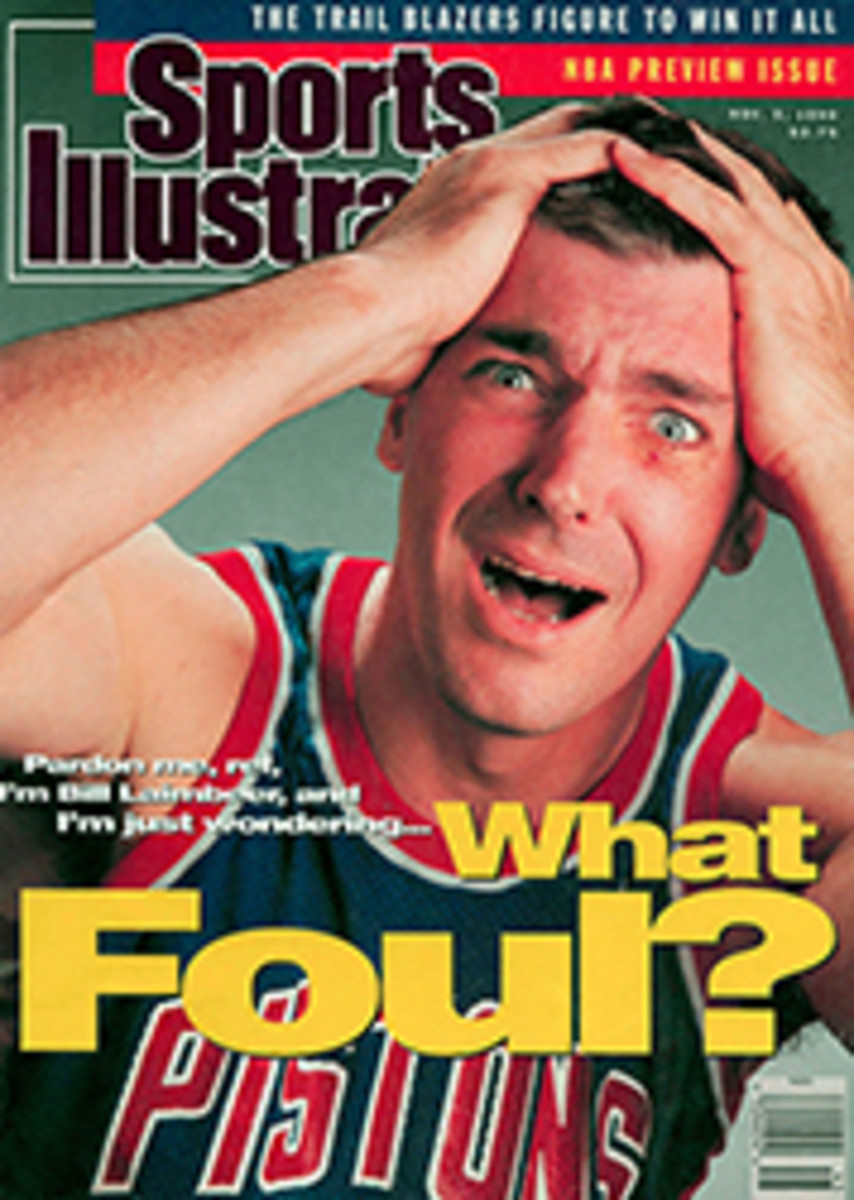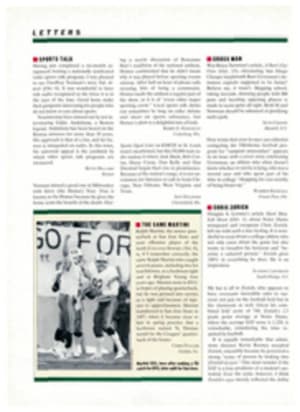
GOLF AT YOUR FINGERTIPS
After generations of duffers flailing away with niblicks and mashies, scores of Scots scraping with spoons and cleeks, and untold numbers of golf sufferers slashing with brassies and baffles, we may have finally discovered the perfect implement for hitting a golf ball: the microchip. Say goodbye to those three-hour waits to tee off at your local muni and to lugging around those perimeter-weighted, square-grooved Pings in 100° heat. Pull up a chair in your den, pop a game cartridge or disk into your personal computer or home arcade system, and let a video golf game transport you to a world of 30-minute 18-hole rounds and sweetly struck two irons.
No sport may be better suited to video simulation than golf. Because golf is an individual sport, you only have to control one action. The main drawback to video games for team sports is that you have to fumble with an array of buttons in trying to control numerous characters on the screen. Also, because golf requires relatively few movements, video simulations can be extremely detailed and accurate, down to the precise mechanics of the swing. And as in real golf, your primary adversary is the course and not other players, so everybody plays to his own ability; you're limited only by your skill and not by that of your opponent.
The best golf simulation for the personal computer is PGA Tour Golf (Electronic Arts, $49.95), which is endorsed by the PGA Tour. It's designed to allow you to compete against 60 Tour pros, including Paul Azinger, Larry Mize, Fred Couples and Craig Stadler, whose playing tendencies have been programmed into the game. You can play four courses, three of them detailed simulations of courses used on the Tour—TPC at Avenel, TPC at Sawgrass and PGA West—and a fictional course called Sterling Shores. The graphics are astounding, from each hole's fly-by preview, which is as good as anything you see on television, to the three-dimensional contoured grid that shows the slopes of the green. No detail is overlooked. You can check your ball position, wait for gusts of wind, and if you've got a nice, firm lie on the fairway, a crisp iron shot will produce a sharp bite on the ball.
As with most video golf games, your swing is controlled by the space bar or a mouse. To begin your backswing, you tap the space bar or mouse once. When the power gauge at the bottom of the screen reaches the strength level you want, you tap the bar or mouse again and you're into the downswing. When the gauge comes back down to zero, you tap one more time to make contact with the ball. Tap too early and the ball will hook. Tap too late and the ball slices. The power gauge allows you to hit the ball with any fraction of a club's normal capability, or even to overhit for extra yardage. But an error on the downswing will be exaggerated, sending the ball left or right.
Although you can play a practice round by yourself, the best part of PGA Tour Golf is the tournament competition. As many as four people can play against an entire field of professional golfers. Throughout your round, the computer lets you know how the pros are faring, so you really get the feel of tournament golf. You don't know what pressure is until you need to birdie the infamous par-3 island 17th at Sawgrass to make the cut. And you don't know what agony is until you have watched your desperate drive on 18 sail into the drink. After every round you play, the program updates detailed, Tour-like personal stats, such as greens hit in regulation, longest drive and driving accuracy, so that you can compare your overall performance with the pros.
Another intriguing computer game is Jack Nicklaus' Unlimited Golf & Course Design (Accolade, $59.95). Unlimited is actually two programs, the video game and the course designer. The video game is a sequel to Accolade's highly successful Jack Nicklaus' Greatest 18 Holes of Major Championship Golf The game is a bit easier to play than PGA Tour Golf but it is entertaining nonetheless. Accolade has added a variety of new features to the original program, including reverse angle and instant replay, variable weather conditions and a two-dimensional grid to help you read the greens. The program comes with two courses, a simulation of Nicklaus's own Muirfield Village and The Bear's Track, a course that Nicklaus designed for the Accolade program. Other Accolade course disks will also work with the new Unlimited version.
The novel part of Unlimited is the design program, which allows you to create your own courses or to make changes in existing layouts. You can choose from different plots of land, build hills and valleys, sculpt terrain, paint in backgrounds and add trees, lakes and bunkers wherever you want, all with ease (a mouse comes in very handy, though you also can work from the keyboard). And then when you are finished, you can play your new design.
Be warned, this is a serious toy. Don't fool around with the course editor unless you've got a couple of hours. The instruction booklet is 156 pages long and covers everything from dealing with the program map (a flowchart of design functions) to the basic principles of Nicklaus's design philosophy. However, once you master the course designer, you'll be hooked.
Strangely enough, golf simulations may be the only video games that play better on a personal computer than on a home arcade system. That's because a computer handles the complexities involved in planning a golf shot (a fairly static activity) better than an arcade system, which is more suited for fast-paced, simplistic actions. Currently, only a couple of golf games for home arcade units are of any interest. The best one is Power Golf (NEC Technologies, $61.99) for the Turbo-Grafx-16 system. Power Golf has outstanding graphics—on some lofted shots you can see the dimples on the golf ball—and colors so vivid that you could almost be content simply looking at some holes. Most of the game is played from an overhead perspective; when you're ready to hit, a small screen insert opens up showing your stance and the power bar.
The game is quick-paced and fairly realistic. One nice feature is that after you hit a shot, the overhead view tracks the flight of the ball. The main drawbacks are that the game has only one fictional, albeit difficult, course to play, and the background music is incredibly annoying. But if you don't mind playing the same course over and over, and have a mute button on your TV, Power Golf should keep you glued to your couch.
The other worthwhile home arcade game is Arnold Palmer Tournament Golf (Sega, $49.95) for the Sega Genesis system. Arnold Palmer offers an intriguing twist: As you master the game, the program automatically upgrades your skills, your equipment and even your caddie's advice. When you're ranked No. 1 in tournament play, you earn a new set of clubs, and if you finish in the top half of the field of 16 you will get more control over the direction of the ball and more detailed advice from your caddie—about yardage to the target, for example, or how to play certain lies.
Arnold Palmer has a few quirks that take some getting used to. For one thing, the third tap on the power button, which in most games controls hooking and slicing, affects the height of your shot. In this game you use a separate button to adjust your stance for a hook or slice. Also, the low viewing angle of the hole makes it tough to figure out exactly where to aim. Moreover, the ball tends to react like a shot put when it lands in the rough but like a Ping-Pong ball when it comes down around the greens. If you're used to other video golf games, take a few practice rounds before you try tournament play on this one.
Because these video golf games are so sophisticated and incorporate so many of the same elements of the real game, after a while you may find that your video golf game starts to resemble your real game. And who knows, if the converse is true, perhaps in the future you'll hear your local pro saying, "Now, tap the button lightly as the power bar is almost at the bottom, and keep your head down!"
FOUR PHOTOS
BRET WILLS
"PGA Tour Golf" offers everything from pro shop to green, with stats in between
PHOTO
BRET WILLS
If you don't like where a trap is in Nicklaus's game, you can redesign the course.

